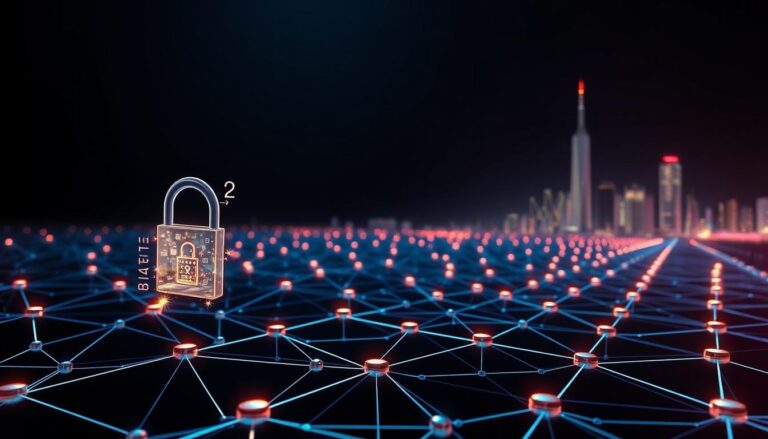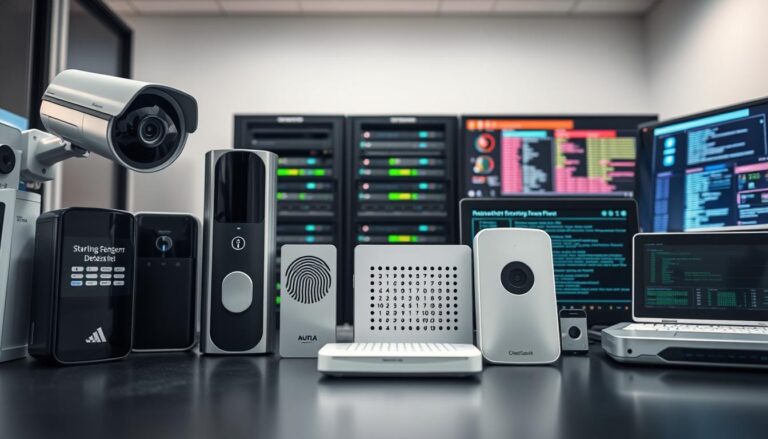Cybersecurity Predictions for the Next 5 Years
The next five years will reshape how U.S. organizations defend their systems and protect data. Last year saw more than 30,000 vulnerabilities disclosed, a 17% rise, and that trend points to expanding exposure as remote work and cloud adoption widen attack surfaces.
This report takes an evidence-driven view of what comes next. We blend technology outlooks—AI/ML, quantum-ready cryptography—and business realities like identity modernization and software supply chain governance.
Regulatory steps such as CISA’s Secure by Design and a new incident reporting portal raise expectations for trust and transparency across the software ecosystem.
Security leaders need pragmatic direction that helps protect data, enable business, and keep resilience amid continual change. IBM’s findings—large increases in attacks using stolen credentials and more cloud intrusions—underscore why action is urgent.
Key Takeaways
- Vulnerabilities are rising; U.S. organizations must act now to reduce exposure.
- Expect technology and regulation to jointly shape priorities for the next five years.
- Identity, cloud, and supply chain hygiene will be central to defense strategies.
- Trust and transparent reporting will become competitive differentiators.
- Our report offers practical, evidence-based guidance to guide security leaders.
Why Trend Analysis Matters Now: Context, Scope, and Methodology
We combine federal signals, standards work, and market telemetry to turn noisy inputs into clear, actionable roadmaps. This approach helps U.S. teams align security plans with real-world incident patterns and policy shifts.
Future-focused lens
Scope: a U.S.-anchored five-year outlook that factors in global spillover from adversary tradecraft and regulatory change. We use year-over-year incident and vulnerability updates to ground forecasts.
Data signals used
Inputs: CISA Secure by Design signatories and the Cyber Incident Reporting Portal, plus NIST’s post-quantum cryptography selections and ongoing updates. Market research—like a 71% rise in compromised-credential attacks and cloud intrusion spikes—adds operational context.
How we weigh signals
We prioritize detection telemetry and breach patterns to highlight near-term risks (credential misuse, cloud intrusions) while tracking longer-range shifts (quantum readiness and crypto agility).
- Framework: balance compliance obligations with practical processes that map to budget cycles and roadmaps.
- Baselining: align mean time to detect and respond with trend indicators so organizations measure progress objectively.
- Scenario analysis: model how U.S. regulations and standards can propagate internationally and affect multinational operations.
Cybersecurity Predictions: The Top Themes Shaping the Next Five Years
Across enterprises, a few dominant themes—automation, identity, crypto readiness, and supply chain visibility—will drive how teams reduce risk and protect data.
AI everywhere: adversaries use machine learning to scale phishing and craft malware variants. At the same time, organizations deploy automation for investigation and response to keep pace with higher attack volumes.
Identity-first security: identity fabric patterns and zero trust will become the operating model for distributed, multicloud environments. Continuous verification and policy-driven access controls help maintain least privilege across applications and models.
Quantum risk and post-quantum readiness: NIST’s initial standards start crypto modernization. Teams must inventory cryptography, assess dependencies, and pilot post-quantum algorithms to avoid migration friction.
Supply chain and software provenance: SBOMs, third-party attestations, and ongoing supplier monitoring become table stakes. Improving verification rebuilds trust across delivery pipelines and reduces copycat attack risk.
- Multicloud realities: integrate cloud-native controls and shared-responsibility models to cut attack paths.
- Threat detection: boost analytics and contextual telemetry so teams can contain attacks faster.
AI Trendlines: From AI-Assisted Attacks to Trustworthy AI Security
Machine learning shifted from research to frontline risk in 2024. Attackers used models to scale social engineering and to tamper with model behavior. Defenders must respond across data, APIs, and MLOps.
AI-assisted vs. AI-powered threats
AI-assisted attacks are common today: automated lure generation and deepfakes boost phishing success and fraud rates. AI-powered threats will grow, enabling autonomous attack campaigns and model sabotage.
Shadow AI and governance
Shadow AI inside teams increases the risk of inadvertent data exposure. Controls should include model registration, access policies, and workforce training to curb policy drift.
Data and model resilience
Robust data security is the backbone of trustworthy AI. Protect inputs, outputs, and pipelines from tampering, theft, and prompt injection to preserve model integrity.
Operational secure-by-design
Integrate API authentication, integrity checks, dependency scans, and resilient MLOps with change control and rollback. Monitor threat actors targeting model supply chains and keep clear playbooks for swift detection and response.
- Tip: unify model observability with incident workflows so teams can triage without slowing innovation.
Identity, Access, and Zero Trust: Redefining Perimeters for Hybrid Work
Identity is shifting from a perimeter control to the core fabric that links users, devices, and apps across hybrid environments.
IBM forecasts an identity-first approach where an identity fabric integrates directories, policy engines, and governance across multicloud footprints. This pattern simplifies policy enforcement and reduces fragmentation for organizations managing many environments.
Identity fabric for multicloud operations and app modernization
The fabric centralizes identity, access, and governance so companies can apply consistent rules across legacy and cloud-native apps. It reduces blind spots and speeds compliance through unified logs and controls.
Beyond VPNs: software-defined perimeters and secure remote access
SEI/CERT notes VPNs still enable many compromises. Software-defined perimeters (SDPs) authenticate users and devices before granting app-level access. SDPs improve monitoring and containment and lower lateral movement when threats appear.
- Zero trust in practice: continuous verification, least privilege, and segmentation for hybrid work.
- Hardening identity: adaptive MFA, passwordless options, device trust, and session controls to counter the 71% rise in credential attacks.
- Real-time policy: trust signals and contextual detection inform access decisions and speed incident response.
Quantum Computing and Crypto Agility: Preparing for the Post-Quantum Era
The harvest-now-decrypt-later threat makes long-lived secrets strategic liabilities today.
Harvest-now-decrypt-later: risk to critical data and long-lived secrets
Adversaries can capture encrypted archives now and decrypt them later as quantum computing improves. This raises special risks for regulated records, archived backups, and long-lived keys.
NIST post-quantum cryptography standards: migration paths and timelines
NIST’s initial post-quantum cryptography choices start the migration clock. Practical phases include algorithm selection, pilot deployments, and broad compatibility testing across models and apps.
Crypto agility and automation: discovering encrypted assets at scale
Crypto agility demands centralized key lifecycle management, automated rollovers, and versioning. Discovering where encryption is used—apps, services, and embedded devices—lets organizations sequence updates by business impact.
| Phase | Actions | Objective |
|---|---|---|
| Inventory | Discover keys, certs, and encrypted archives | Prioritize critical data and long-lived secrets |
| Pilot | Test post-quantum algorithms in non-production | Validate compatibility and performance |
| Rollout | Staged migration with automated rotations | Minimize disruption and preserve trust |
| Governance | Metrics, playbooks, and emergency rotations | Track progress and reduce organizational risk |
Response playbooks and governance
Prepare emergency rotation playbooks for algorithm deprecation. Tie technology choices to measurable risk reduction so leadership can report readiness and maintain trust.
Cloud, Edge, and Container Security: Scaling Detection and Response
A surge in cloud intrusions and misconfigurations is forcing teams to rethink how they detect and respond across multicloud environments. IBM’s findings and Sentinel research show stolen credentials and unpatched images drive many incidents.

Multicloud intrusion patterns and misconfiguration risks
Misconfigurations and weak identities turn simple setups into exploitable vulnerabilities. That creates noisy incident queues and longer recovery times.
Companies should map where sensitive data and keys live across providers and enforce least-privilege defaults to shrink the blast radius.
Edge and 5G: firmware, identity, and real-time ops
Edge nodes and 5G-connected systems push workloads closer to data centers and users. Firmware integrity checks, lightweight identity, and secure OTA updates are vital.
Hardened systems reduce latency impact while protecting near-real-time operations from device-level threats.
Containers and microservices: shift-left and image hygiene
Shift-left measures cut vulnerabilities early: scan base images, enforce signing, and gate builds before deployment.
Combine policy-as-code, immutable infrastructure, and secret management to lower human error and speed detection across services.
- Telemetry standardization: unify logs and cloud-native detection to speed correlation and response.
- Data minimization: limit sensitive footprints so companies can operate across regions and providers with confidence.
Supply Chain, Third Parties, and Software Provenance
Supply chain compromises now include tampered updates, rogue dependencies, and abused service relationships that hide risk until it’s too late.
SEI/CERT warns visibility into software supply chains remains limited. That gap lets copycat incidents mimic SolarWinds and BeyondTrust patterns.
From SolarWinds to copycats: securing updates and service providers
Modern supply chain risk modes range from malicious updates to compromised service providers and firmware backdoors like UEFI. Real-time validation of artifacts and delivery channels is essential to stop wide-scale impact.
SBOMs, continuous compliance, and real-time partner monitoring
SBOMs should be living inventories. They help map components, correlate vulnerabilities across products, and speed remediation across organizations and companies.
| Risk Mode | Mitigation | Contract Controls | Outcome |
|---|---|---|---|
| Tampered updates | Artifact signing, attestation | Breach SLAs, secure dev clauses | Faster containment |
| Compromised service providers | Runtime posture monitoring | Independent attestations, pen tests | Verified partner behavior |
| Shared infrastructure | Network segmentation, least privilege | Data center segmentation requirements | Reduced lateral risk |
Best practices include third-party due diligence, contractual policies for rapid remediation, and solutions that baseline partner behaviors and surface drift. These steps rebuild trust and reduce the attack surface across the broader threat landscape.
Sector Outlook: Industry-Specific Risks, Regulations, and Responses
From hospitals to factories, operational realities and regulations force tailored security investments that limit exposure and speed recovery.

Healthcare
Ransomware resilience and patient privacy are top priorities. Healthcare breach costs averaged about USD 9.77 million between 2022–2024, so segmentation and tested backups matter.
Deploy endpoint protection, HIPAA-aligned data controls, and rapid restore plans to cut downtime and overall cost.
Financial services
Banks and payment firms balance PCI DSS obligations with real-time anomaly detection.
Combine device trust with cross-system correlation to speed containment of attacks in cloud or on-prem services.
Retail and e-commerce
Retailers face fraud, credential stuffing, and seasonal spikes that hit checkout flows and loyalty programs.
Use WAF with bot management and embed secure coding and scanning into DevSecOps to curb phishing and fraud.
Government and public sector
Legacy systems slow adoption, but zero trust roadmaps are accelerating across agencies.
Practical migration steps help sustain operations while meeting new compliance and regulations demands.
Manufacturing and industrial IoT
IT/OT convergence exposes controllers and data centers to lateral movement.
Integrate IT/OT visibility, enforce micro-segmentation on production lines, and monitor for unusual behavior to protect systems and operations.
- Cross-sector priority: align organizations on risk-based investments so businesses can meet compliance and regulatory expectations while improving security outcomes.
Execution Challenges: Budgets, Workforce, and Secure-by-Design Momentum
Resource shortfalls are pushing businesses to outsource more functions, sometimes without full visibility. That trend raises exposure for small and mid-size firms and shifts demand toward managed services.
The cyber poverty line and managed services
SEI/CERT projects a rising cyber poverty line that drives SMBs toward MSSPs. Managed services can close gaps fast, but black-box offerings may hide risk.
“Delegated defenses must include transparency controls so an organization retains visibility and control over critical assets.”
Workforce and automation
The workforce gap persists despite training programs. Upskilling and automation of routine tasks stretch limited resources.
Selective outsourcing plus clear SLAs helps preserve trust and control while easing day-to-day burdens.
Compliance fragmentation and cost pressures
Fragmented privacy laws and regulations raise operational cost for many organizations. Streamlined processes and tooling cut compliance overhead without weakening outcomes.
| Challenge | Impact | Recommended action |
|---|---|---|
| SMB exposure | Higher breach risk, limited budgets | Transparent MSSP contracts, shared telemetry |
| Workforce shortage | Slower response, skill gaps | Upskill pipelines, automate routine ops |
| Balkanized compliance | Rising operational cost | Process automation, unified controls |
| Legacy access (VPN) | Lateral movement risk | Adopt software-defined perimeters and least-privilege |
Business-aligned cases that link risk reduction to productivity gains and incident cost avoidance help leaders fund secure-by-design work. That approach builds trust and stretches scarce resources further.
Conclusion
, strong. Leaders must treat the next five years as a steady cycle of improvement, not a one-time effort.
Sustained trends in AI, identity, cloud, quantum readiness, and supply chain resilience will unfold over each year and require repeated attention and small wins over time.
Executives should link strategy to clear solutions, assign owners, and track metrics so teams can speed detection and response. Work with regulators, vendors, and peers to lift security posture and build trust.
Invest in data-centric safeguards, zero trust access, and resilient architectures that raise the cost for threat actors while preserving agility.
Call to action: institutionalize threat detection, codify lessons into playbooks, and schedule regular reviews to verify progress over time. Start now—align people, process, and technology to gain durable advantage in cybersecurity.
FAQ
What are the most important themes shaping security over the next five years?
The top themes include broad use of machine learning for both attacks and defense, identity-first security with zero trust as the default model, preparing for quantum-era threats with post-quantum cryptography, and much greater focus on software provenance and supply chain transparency. These trends affect risk, operations, and compliance across industries.
How does the United States threat landscape affect global security trends?
The U.S. often drives incident reporting, regulation, and capability development. CISA guidance, federal mandates, and major breaches shape vendor practices and attacker tactics worldwide. Global spillover occurs via supply chains, cloud providers, and shared software components, making U.S. signals relevant to multinational risk planning.
What data sources inform these trend assessments?
Analysts use a mix of CISA advisories, NIST standards (including PQC work), incident disclosure data, vendor telemetry, market research, and academic studies. Combining operational incident trends with standards roadmaps gives a practical view of risk and recommended controls.
How will artificial intelligence change attack and defense strategies?
AI will speed and scale social engineering (deepfakes, targeted phishing) and automate reconnaissance, while defenders will deploy ML for anomaly detection, automated response, and model risk management. The net effect is faster attack cycles, so teams must invest in detection automation and model governance.
What is “shadow AI” and why is it a concern?
Shadow AI refers to unsanctioned use of generative models and cloud services by employees. It raises data exposure and compliance risks because models can leak sensitive inputs, and third-party services may store or reuse data. Organizations need discovery, policy enforcement, and secure alternatives.
How should organizations approach data and model security for AI initiatives?
Treat data and model artifacts as critical assets: apply access controls, encryption, provenance tracking, and secure MLOps pipelines. Implement monitoring for data drift and anomalous inference patterns, and enforce privacy-preserving techniques where needed.
What does identity-first security mean for hybrid workforces?
Identity-first security shifts the security perimeter from network location to authenticated identity and device posture. For hybrid work, that means strong multi-factor authentication, continuous device hygiene checks, and dynamic access policies tied to risk signals rather than VPN-based trusts.
When should organizations begin post-quantum planning?
Start now for assets with long confidentiality requirements or long-lived keys (the “harvest-now-decrypt-later” risk). Follow NIST timelines for algorithm selection, inventory cryptographic assets, and plan crypto-agility measures to swap algorithms with minimal disruption.
What steps improve crypto agility at scale?
Maintain a current inventory of cryptographic usage, adopt abstraction layers for crypto libraries, use automated discovery for encrypted assets, and test migration paths in staging. Automation reduces manual error and speeds transitions when standards evolve.
What cloud and container risks deserve priority attention?
Misconfigurations, excessive privileges, and insecure images top the list. Focus on least privilege IAM, continuous scanning of container images, shift-left security in CI/CD, and robust detection for lateral movement inside cloud environments.
How will 5G and edge deployments change operational risk?
5G and edge systems increase the attack surface for firmware and identity exploits and demand low-latency, secure operations. Ensure strong device identity, secure update mechanisms, and segmentation between edge workloads and critical backend systems.
What practices reduce software supply chain risk?
Implement SBOMs for visibility, enforce signed and verified updates, require third-party security attestations, and monitor partners continuously. Continuous compliance checks and real-time partner monitoring help catch malicious or vulnerable components sooner.
How should sectors like healthcare and finance prioritize investments?
Healthcare should prioritize ransomware resilience, endpoint protection, and HIPAA-aligned privacy controls. Financial services need anomaly detection, device trust, and strict PCI/AML compliance. Each sector should map controls to their most critical assets and regulatory obligations.
What options exist for resource-constrained organizations facing talent shortages?
Smaller organizations can use managed security service providers (MSSPs), adopt secure-by-design frameworks, and automate repetitive detection and response tasks. Upskilling existing staff and leveraging cloud-native security services also stretch limited budgets and capacity.
How will evolving privacy laws affect operational costs and compliance?
Fragmented privacy requirements increase compliance overhead and require adaptive data governance. Organizations should centralize privacy controls, automate data subject request handling, and design systems to minimize data retention to reduce both risk and cost.







